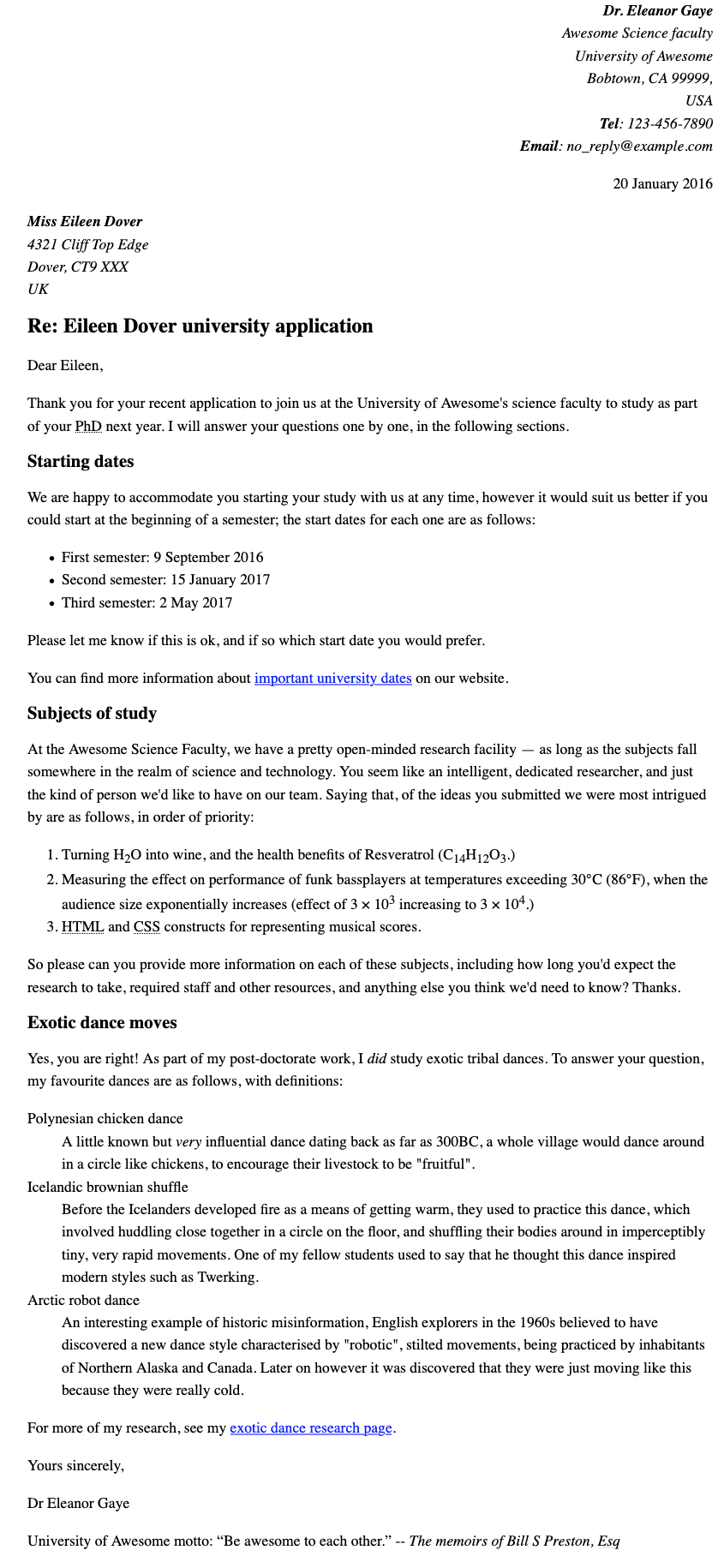Marking up a letter
We all learn to write a letter sooner or later; it is also a useful example to test our text formatting skills. In this assignment, you'll have a letter to mark up as a test for your HTML text formatting skills, as well as hyperlinks and proper use of the HTML <head> element.
| Prerequisites: | Before attempting this assessment you should have already worked through Getting started with HTML, What's in the head? Metadata in HTML, HTML text fundamentals, Creating hyperlinks, and Advanced text formatting. |
|---|---|
| Objective: | Test basic and advanced HTML text formatting, use of hyperlinks, and use of HTML <head>. |
Starting point
To begin, get the raw text you need to mark up, and the CSS to style the HTML. Create a new .html file using your text editor or use an online tool such as CodePen, jsFiddle, or Glitch to complete the tasks.
Note: If you get stuck, then ask us for help — see the Assessment or further help section at the bottom of this page.
Project brief
For this project, your task is to mark up a letter that needs to be hosted on a university intranet. The letter is a response from a research fellow to a prospective PhD student concerning their application to the university.
Block/structural semantics
- Use appropriate document structure including doctype, and
<html>,<head>and<body>elements. - In general, the letter should be marked up as an organization of headings and paragraphs, with the following exception. There is one top level heading (the "Re:" line) and three second level headings.
- Use an appropriate list type to mark up the semester start dates, study subjects, and exotic dances.
- Put the two addresses inside
<address>elements. Each line of the address should sit on a new line, but not be in a new paragraph.
Inline semantics
- The names of the sender and receiver (and Tel and Email) should be marked up with strong importance.
- The four dates in the document should have appropriate elements containing machine-readable dates.
- The first address and first date in the letter should have a class attribute value of sender-column. The CSS you'll add later will cause these to be right aligned, as it should be in the case in a classic letter layout.
- Mark up the following five acronyms/abbreviations in the main text of the letter — "PhD," "HTML," "CSS," "BC," and "Esq." — to provide expansions of each one.
- The six sub/superscripts should be marked up appropriately — in the chemical formulae, and the numbers 103 and 104 (they should be 10 to the power of 3 and 4, respectively).
- Try to mark up at least two appropriate words in the text with strong importance/emphasis.
- There are two places where the letter should have a hyperlink. Add appropriate links with titles. For the location that the links point to, you may use http://example.com as the URL.
- Mark up the university motto quote and citation with appropriate elements.
The head of the document
- The character set of the document should be set as utf-8 using the appropriate meta tag.
- The author of the letter should be specified in an appropriate meta tag.
- The provided CSS should be included inside an appropriate tag.
Hints and tips
- Use the W3C HTML validator to validate your HTML. Award yourself bonus points if it validates.
- You don't need to know any CSS to do this assignment. You just need to put the provided CSS inside an HTML element.
Example
The following screenshot shows an example of what the letter might look like after being marked up.

Assessment or further help
If you would like your work assessed, or are stuck and want to ask for help:
- Put your work into an online shareable editor such as CodePen, jsFiddle, or Glitch.
- Write a post asking for assessment and/or help at the MDN Discourse forum Learning category. Your post should include:
- A descriptive title such as "Assessment wanted for Marking up a letter".
- Details of what you have already tried, and what you would like us to do, e.g. if you are stuck and need help, or want an assessment.
- A link to the example you want assessed or need help with, in an online shareable editor (as mentioned in step 1 above). This is a good practice to get into — it's very hard to help someone with a coding problem if you can't see their code.
- A link to the actual task or assessment page, so we can find the question you want help with.